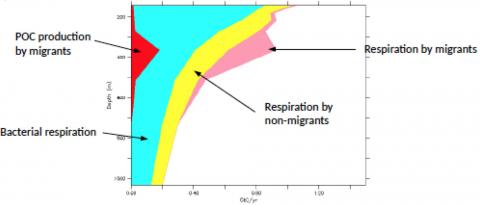Project 10 (WP1, collaboration with LABEX MER): Role of daily vertical migrations of zooplankton on carbon cycle
Project lead: Laurent Bopp
Post-doctoral researcher: Stelly Lefort
Project Start/End: September 2014 – April 2015
The diurnal vertical migration (DVM) of zooplankton is a widespread phenomenon in the marine environment. Conventionally, zooplankton is at the surface during the night and goes down to several hundred meters at dawn. These migrations may have an impact on the biogeochemical fluxes of nutrients, carbon and oxygen. Migrant organisms will generally feed on the surface, but they excrete, respire, produce fecal pellets and die at depth, inducing a vertical transport of nutrients and carbon from the surface to the subsurface. This could increase the efficiency of the carbon pump. Numerous studies have shown the importance of this active transport, that could contribute up to 10-30% of the global carbon export.
The opportunity to co-design a ocean-focused project with the Labex Mer “A changing Ocean” (at the Université Bretagne Occidentale) has led to propose to work on the incorporation of zooplankton diurnal migration in the PISCES model (marine biogeochemical component of the IPSL earth System Model). This has ben achieved by the coupling of PISCES with APECOSM (Maury, 2010), a model of marine upper trophic levels, which includes an explicit representation of migratory communities .
The first simulations using the coupled PISCES-APECOSM model have enabled to explicitly model the role of diurnal migration on marine biogeochemistry. Export of carbon induced by diel migrations is estimated to be about 13% of totalExport (Figure 1) . The concentrations of sub-surface oxygen appear to be very sensitive to the active export of organic matter through diurnal migration (Aumont et al. in prep)
Figure 1 : Contributino of active / passive export to the export of carbon from the surface to the deep ocean (annual-mean, averaged over the global ocean).
In a second step, the coupled PISCES-APECOSM model has been forced by the output of the IPSL earth system model over the 21st century (RCP8.5 scenario) to explore the role of that active transport of carbon through diurnal vertical migration in a changing climate. Early results show that these processes have little impact on air-sea carbon fluxes and oceanic carbon storage in response to anthropogenic climate change (Lefort et al. in prep).
Position offer and results (January 2017 update)

